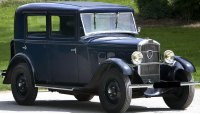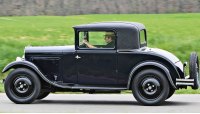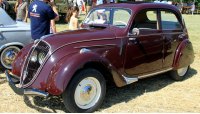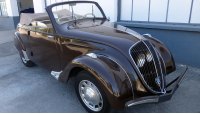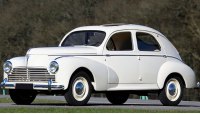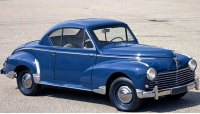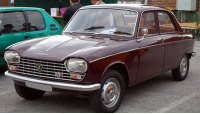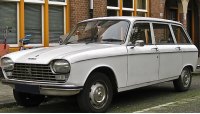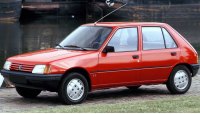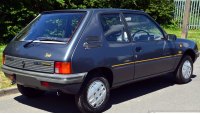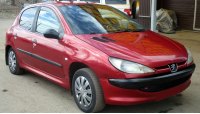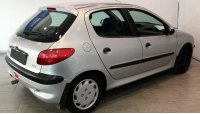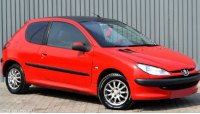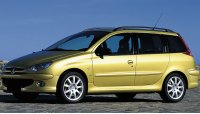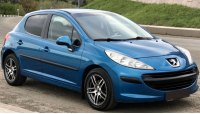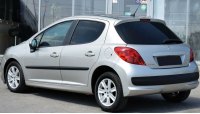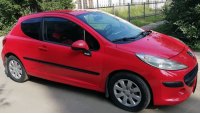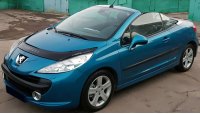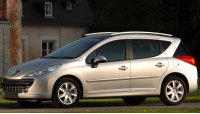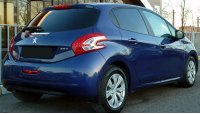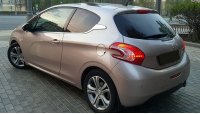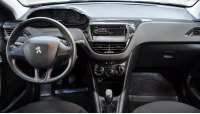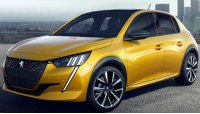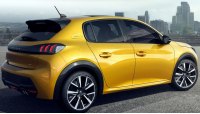Share information:
Peugeot 201 (1929-1937)
Peugeot 201 - small car (B-segment), produced from 1929 to 1937 by the French automobile manufacturer «Peugeot». It is considered the first mass-produced car produced by this company. It was introduced at the 23rd Paris Motor Show, held in October 1929 against the backdrop of a serious stock market crash. This further helped the company a little car and in the market due to the low price and low operating costs. The body was mainly a four-door sedan with a length of 3800 mm, a width of 1350 mm and a curb weight of 890 kg, but there were other body options - coupe, van and convertible. More than 140 thousand cars were produced.
The engine was located in front longitudinally, rear-wheel drive. First, a 1.1-liter four-cylinder gasoline engine was installed (1085 cm3) with a capacity of 23 hp, in 1934 a 1.3-liter engine appeared (1307 cm3) 28 hp, and in 1936 a 1.5-liter engine appeared (1465 cm3) 35 hp. The gearbox was a three-speed mechanics.
In 1931, independent front suspension appeared on the model for the first time «201С», which significantly improved handling and ride comfort. During the release of the model, the car underwent various improvements and new options appeared.
Peugeot 202 (1938-1948)
Peugeot 202 - subcompact french car (B-segment), produced from January 1938 to 1942. Then, due to the Second World War, production had to be stopped and resumed only in 1946, after it ended, and continued production until 1948. At the Paris Motor Show in 1937, the company «Peugeot» conducted a massive survey of visitors to find out what kind of small car people want to have. The car was officially shown to the press on March 2, 1938 in the Bois de Boulogne near Paris. The body was a four-door sedan «berline» (length 4110 mm, width 1500 mm, height 1550 mm), a two-door pickup and a four- or two-door convertible. The curb weight was 890 kg. The front doors were rear-hinged or, as they are also called - «suicide doors». In total, about 105 thousand cars were produced. Due to the lack of sheet steel in post-war France, since 1947, wooden hatchback bodies have been produced «hatch» with longer chassis (length 4430 mm, width 1590 mm, height 1550 mm).
The engine was located longitudinally in front, rear-wheel drive through a three-speed manual transmission with synchronization in second and third gear. The engine was a four-cylinder in-line gasoline, water-cooled, 1.1 liter (1133 cm3, OHV) 30 hp, carburetor fuel system «Solex 26 IAC». The maximum speed of the car with this engine was 100 km / h. The front suspension became independent on all cars of this generation due to the success of its predecessor «201C».
During the entire production phase, improvements were made. In 1946, they began to install a hydraulic brake system.
Peugeot 203 (1948-1960)
Peugeot 203 - mid-size family car (D-segment), which was produced by the French company «Peugeot» from the end of 1948 to February 1960. This is the first new car model released by the company after the war and until 1955 it was the only model in production. It was introduced in October 1947 at the Paris Motor Show. For the first time began to use a load-bearing body «monocoque». At first, only a four-door sedan was produced with a length of 4350 mm, a width of 1620 mm, and a height of 1500 mm. Since 1950, they began to offer a five-door station wagon with a length of 4530 mm, four or six (three rows of seats). There was also a two- or four-door convertible, as well as a two-door coupe. Over 12 years of the model's life, more than 680 thousand copies were produced due to the lack of competitors in France in this automotive niche.
The gasoline in-line engine was located longitudinally in front, the rear-wheel drive was carried out through a four-speed manual gearbox. The engine was 1.3 liters (1290 cm3) 42 hp. The maximum speed with such an engine was 115 km / h for a sedan.
In October 1952, a modified model was presented at the Paris Motor Show. Engine power was increased to 45 hp. with an increase in maximum speed up to 120 km / h. Changes were also made to the exterior design and interior. Since 1953, the car began to be produced in Australia. In 1960, production was stopped.
Peugeot 204 (1965-1976)
Peugeot 204 - small family car (C-segment), which was produced by the French company «Peugeot» from April 1965 to July 1976. It is the best selling car in France from 1969 to 1971. The design was developed by an Italian firm «Pininfarina». For the first time, front-wheel drive with a transverse engine was used, which significantly influenced the external design and greatly increased the interior space. There were many body options - a four-door sedan, a five-door station wagon, a three-door hatchback, as well as a two-door coupe, convertible and van. The length of the car was 3735-3990 mm, width 1560 mm, height 1320-1400 mm and curb weight 851 kg. For the first time, disc brakes were installed on the front wheels. In total, more than 600 thousand cars were produced.
First, a 1.1-liter four-cylinder gasoline engine was installed (1127 cm3) with a power of 59 hp, the car developed a maximum speed of 138 km / h. Since 1968, a 1.3-liter four-cylinder diesel engine has become available (1255 cm3) with a capacity of 40 hp, which in 1973 was increased to 1.4 liters (1357 cm3) 45 hp. The gearbox was a mechanical four-speed with synchronizers in all gears.
In 1969 it was put into production «Peugeot 304», which was essentially «204» with a more powerful engine, larger trunk and a slightly modified exterior design. For the entire period of the release of the model «204» it was changed very little, the most notable restyling was carried out in 1975, a year before the end of production.
Peugeot 205 (1983-1998)
Peugeot 205 - small French car (B-segment). Produced from February 1983 to April 1998 by the automaker «Peugeot». The car immediately gained popularity among car owners. british magazine «What Car?» gave the title «Car of the Year» in 1984, and the magazine «Car» awarded in 1990 the title «Car of the Decade». The body was only a three- or five-door hatchback, as well as a two-door convertible. Body length was 3705 mm, width 1560 mm, height 1375 mm and curb weight 760 kg. MacPherson independent front suspension, rear torsion bar suspension. In total, about 5.3 million cars were produced and it was a record model for the company in the previous history, which was later beaten «Peugeot 206».
Throughout the history of the release of the model, the following gasoline four-cylinder engines were installed - 1.0 liter (954 cm3, TU9, 43 hp), 1.1 liters (1124 cm3, TU1, 53 hp), 1.3 liters (1294 cm3, TU2, 64 hp), 1.4 liters (1360 cm3, TU3, 68 hp), 1.6 liters (1580 cm3, XU5, 78 hp) and 1.9 liters (1905 cm3, XU9, 101 hp). There were also two 1.8-liter four-cylinder diesel engines (1769 cm3, XUD7, 58 hp) and 1.9 liters (1905 cm3, XUD9, 62 hp). The transmission was a four- or five-speed manual, as well as a four-speed automatic.
During the release of the model, the car did not change much in appearance. In 1988 and 1990, minor restyling was carried out. In September 1991 appeared «Peugeot 106», in early 1993, a car was produced «Peugeot 306», all this greatly reduced the demand for «205», although production continued until 1998.
Peugeot 206 (1998-2012)
Peugeot 206 - French subcompact car (B-segment), which is produced by the company «Peugeot» from May 1998 to December 2012. In some countries, it was produced until 2015, and in Iran it is still being produced. This is the best model «Peugeot», whose sales exceeded 10 million units. In China, the car was produced by a joint venture «Dongfeng» And «Peugeot-Citroën» entitled «Citroën C2», which is technically unrelated to the European model of the same name. Assembly was carried out in France, Argentina, Brazil, Great Britain, Indonesia, Iran, China, Malaysia, Uruguay and Chile.
The engine is located transversely in front, the drive was carried out only on the front wheels. The body was basically a three- or five-door hatchback (length 3835 mm, width 1652 mm, height 1428 mm), but also had a two-door coupe-convertible «206 CC» (4000 mm, width 1652 mm, height 1373 mm), five-door station wagon «206 SW» (length 4028 mm, width 1652 mm, height 1460 mm) and four-door sedan «206 SD» (4188 mm, width 1655 mm, height 1456 mm). The curb weight of the car was 950-1145 kg.
The gasoline engines installed over the entire period of production were four-cylinder with the following characteristics:
- 1.0 liter (999 cm3, D4D), 69 hp
- 1.1 liters (1124 cm3, TU1JP), 59 hp
- 1.4 liters (1360 cm3, TU3JP), 74 hp
- 1.4 liters (1360 cm3, ET3J4), 87 hp
- 1.6 liters (1587 cm3, TU5JP), 87 hp
- 1.6 liters (1587 cm3, TU5JP4), 108 hp
- 2.0 liters (1997 cm3, EW10J4), 138 hp
- 2.0 liters (1997 cm3, EW10J4S), 175 hp
Diesel engines were also four-cylinder:
- 1.4 liters (1398 cm3, DV4), 67 hp
- 1.9 liters (1868 cm3, DW8), 70 hp
- 1.6 liters (1560 cm3, DV6), 108 hp
- 2.0 liters (1997 cm3, DW10), 89 hp
The transmission was either a five-speed manual or a four-speed automatic.

A minor facelift in 2003 brought clear headlights, new taillights, new side indicators, chrome badges, a new color scheme, and other minor interior changes.
Peugeot 207 (2006-2014)
Peugeot 207 - small car (B-segment) French company «Peugeot», which was produced between 2006 and 2014. It was the successor to the model «206», based on a modified platform «PSA PF1». Sales began in April 2006 in France, Italy and Spain, and a little later in other countries. The body was a three- or five-door hatchback (length 4045 mm), two-door coupe-convertible «207 CC» (length 4037 mm) and five-door station wagon «SW» (length 4164 mm). The width of all models was 1748 mm, height 1472 mm and curb weight 1243-1283 kg. The car was criticized for the interior design and the quality of the gearbox. The assembly was carried out in France, Spain, Indonesia, Iran and Slovakia. Over 2.5 million units have been sold in total.
All engines were four-cylinder and were located transversely in front, front-wheel drive. At first, there were two modifications of gasoline engines with a volume of 1.4 liters (1360 cm3, 75 and 90 hp) and 1.6 liters (1598 cm3, 110 hp), whose power at the end of 2006 was increased to 95 and 120 hp. respectively. There were also turbocharged engines with 150 and 175 hp. Diesel engines also had two modifications of 1.4 liters (1398 cm3, 70 hp) and 1.6 liters (1560 cm3, 90 and 110 hp), both turbocharged. The transmission was a five- and six-speed manual or five-speed automatic.
Peugeot 208 (2012-present time)
Peugeot 208 - subcompact B-segment, successor to the model «207», produced from 2012 to the present by the French automaker «Peugeot». First presented in March 2012 at the Geneva Motor Show. Platform based «PSA PF1», which also serves as the basis for «Citroën C-Elysée», «Citroen C3 Aircross», «Citroën C4 Cactus», «Peugeot 2008», «Opel Crossland X». The body was produced only in the form of a three- or five-door hatchback with a length of 3962 mm, a width of 1739 mm, a height of 1460 mm and a curb weight of 975-1295 kg. The car was assembled in France, Algeria, Brazil, Iran, Malaysia and Slovakia. Since 2016, the car has not been delivered to Russia.
The development of the car was carried out by the French automotive designer Pierre Autier, the interior design was done by Adam Bazidlo. The car is equipped with a screen similar to a tablet computer, as well as a panoramic glass roof surrounded by LED lights. The aerodynamics of the body has been seriously worked on, now the drag coefficient is 0.29. The interior space for luggage and passengers has increased slightly compared to its predecessor. All petrol engines are compliant «Euro 5», and diesels have CO emissions2 99 g/km or below. The trim and trim levels were as follows − «Active», «Signature», «Tech Edition», «GT-Line» And «GTi».
Four-cylinder gasoline engines were from the previous model, and for the first time, three-cylinder in-line engines with variable valve timing began to be installed. Models of installed gasoline engines were as follows - 1.0 liter (999 cm3, I3, 68 hp), 1.2 liters (1199 cm3, I3, 82 hp), 1.4 liters (1397 cm3, I4, 95 hp), 1.6 liters (1598 cm3, I4, 120 hp) and 1.6 liters (1598 cm3, I4, turbocharged, 156-200 hp). Diesel engines were only four-cylinder 1.4-liter (1397 cm3, i4, 67 hp) and 1.6 liters (1560 cm3, i4, 92 hp). The lowest fuel consumption of a gasoline engine was 4.3 liters per 100 km, diesel 3.4 liters per 100 km. The transmission was a five- or six-speed manual, as well as a four- or six-speed automatic.
In March 2019, the second generation was presented at the Geneva Motor Show «Peugeot 208» with a conventional engine, as well as an all-electric model.
Currently, the main competitors and classmates of the Peugeot 208 are cars from other manufacturers, such as Chevrolet Aveo, Fiat Punto, Fiat Uno, Citroen C3, Ford Fiesta, Honda Jazz, Hyundai i20, Hyundai Solaris, Kia Rio, Opel Corsa, Lada Granta, Mazda 2, Mitsubishi Colt, Nissan Micra, Renault Symbol, Renault Logan, Rover Metro, Suzuki Swift, Škoda Rapid, Toyota Yaris, Volkswagen Polo.

